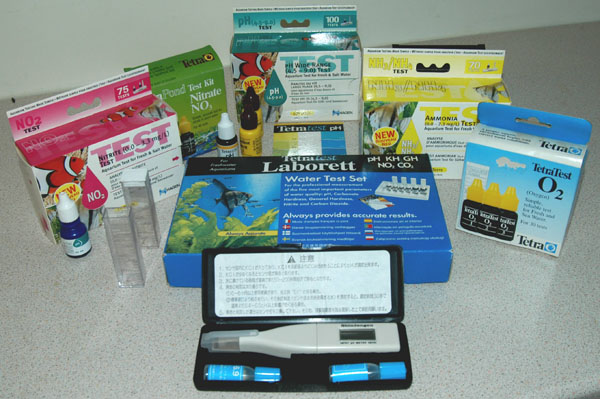Water testing equipment
I use the words ‘water testing’ as opposed to ‘water analysis’ here as these have two entirely different meanings.
‘Water testing’ by the serious Koi keeper only really requires ‘indicators’ for several specific tests with regard to our pond water.
‘Water analysis’, on the other hand, is a far more detailed, and an often difficult to understand series of many specific tests that are usually carried out by the laboratory technicians of water authorities or private water analysis companies at a substantial fee. In most reports that I have come across it is only the final figure that is detailed for each test. This gives no indication at all as to the harm or good a particular reading can be in relationship to your Koi, it is merely a figure.
Bearing in mind that both our mains water and pond water conditions can vary significantly on a day-to-day basis, especially when a new system has to go through the initial ‘maturing process’, today’s Koi keeper really only needs to have on hand, the following ‘indicator test kits’ which are exactly that – ‘Indicators’.
(Whilst these ‘indicators’ give a good general result for pond water parameters as to the particular test in question, they are not nearly as accurate as those produced by water analysis laboratories – nor are they, thankfully, anywhere near as expensive.)
The Tetra Company in Germany has produced water test kits made for both aquarium keepers and pond keepers for many years and I have always found these kits to be excellent ‘indicators’ for the most common water tests required by Koi keepers. ‘Tetra-Tests’ are very easy to use together with clear instructions and colour comparisons, they can be purchased from most aquatic outlets and specialist Koi dealerships quite cheaply and I would never advocate that that these are purchased second-hand. I would also advise the owner that these test kits are discarded to waste after one year and replaced by new ones.
I suggest the following test kits are purchased for your necessary requirements in water testing equipment. In most cases, these tests are really only necessary to make with any regularity when a new system is starting up and water quality fluctuations begin with the maturing of the biological stage of the filter. There may be other times in a mature system when water readings may be worth checking if your Koi are not behaving as usual. More often than not it will be a parasitic problem but symptoms of both imperfect water and a parasitic problem produce the same visual conditions of our Koi. It is advisable therefore to check water readings before taking a mucus sample. There is also more information in the ‘Pond’ section of this site which details the maturing process of the biological stage of a filter.
a. pH test – This test is an indication of the concentration of hydrogen ions in the presence of a changing alkalinity. For our Koi water readings, we require a reading of between 7.00 to 8.00 and this is generally acceptable although a reading of 7.5 to 7.8 is favoured by many. On a new system the pH reading can fluctuate from morning to night as well as on a day-to-day basis. In view of this I would advise that, in a new system, morning and evening readings are taken and recorded two days apart until they become stable. For mature systems, generally a monthly or quarterly pH test is all that is required.
b. Nitrite test – This reading ideally should be zero for optimum water conditions however, this will fluctuate severely on a new system and can prove to be serious if not addressed promptly. If the reading becomes high (as per the colour chart) then feeding should be stopped and constant new water added to the system until the bacterial activity in the filtration system begins to be able to cope with the nitrite build-up. If this problem continues then the ‘effects’ of nitrite on the Koi themselves can be reduced by adding pure cooking salt to the system at the rate of 1.5 kilos per ton (220 UK gallons) of water. In a new system, I suggest that nitrite readings are taken and recorded on a daily basis until they stabilise, after that a monthly or quarterly test should be sufficient.
c. Ammonia test – This reading should also be zero as ammonia build-up can prove to be fatal to our Koi. This reading also manifests itself in a new pond system during the initial maturing process which can take over six weeks to stabilise. High ammonia readings can be extremely dangerous to your Koi. Again, water changes can reduce ammonia build-up and daily tests are vital in a new system.
d. Dissolved Oxygen test – This test can be very helpful during the warm, summer months when high water temperatures can deplete the dissolved oxygen content of the pond water. (A good, reliable thermometer is useful here) Always try to maintain a reading of 6.0ppm and over if possible – this can be achieved, if required, by introducing added aeration from a suitable air pump and air diffusers.
These four indicator tests are really all that are required generally but there are many others available such as nitrate; chlorine; GH; KH; zinc; copper etc. etc. which may well be required from time to time and can also be purchased readily from aquatic outlets or internet suppliers.




